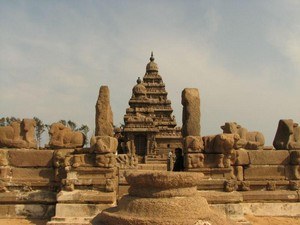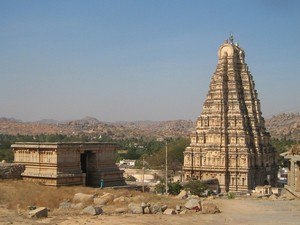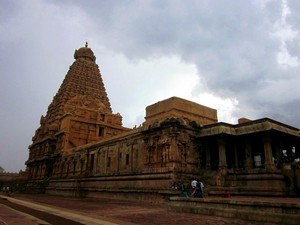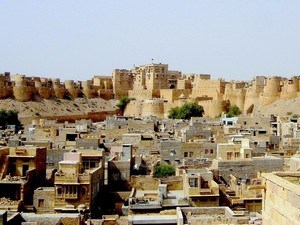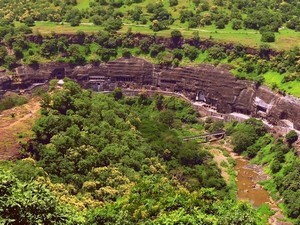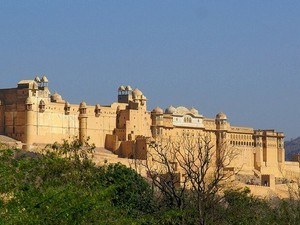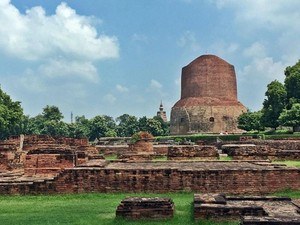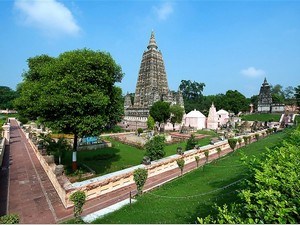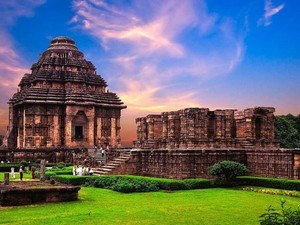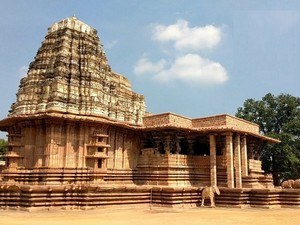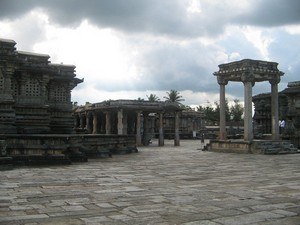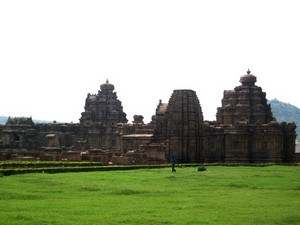1
DAY 1 : JHANSI SIGHTSEEING
DAY 1 : JHANSI SIGHTSEEING
 Sightseeing
Sightseeing
Leisure / No Sightseeing
At a distance of 4 km from Jhansi Junction, Jhansi Fort or Jhansi ka Kila is an ancient and historical fortress situated in the heart of Jhansi, Uttar Pradesh. Atop Bangira hill, Jhansi Fort is the landmark of Jhansi town and also one of the top places to visit in Jhansi.
Jhansi Fort was built by Raja Bir Singh Deo of Orchha in 1613 CE and served as a stronghold of the Chandela Kings from 11th to 17th century AD. In the 18th century, Jhansi served as the capital of Maratha province and later the Princely State of Jhansi from 1804 to 1853 CE. The fort was the residence of the great Rani Lakshmi Bai of Jhansi, who fought the British East India Company during the 1857 War of Independence. This fort has been a witness to the fiery battle led by Rani Lakshmi Bai. During the mutiny, the queen and her army fought fiercely for two weeks.
Sprawling over an area of 15 acres, the fort is built in the north .....
 Duration of visit: 30 Mins - 1 Hr
Duration of visit: 30 Mins - 1 Hr
 Timings: 6 AM to 6.30 PM, Sound & Light Show: 7.30 PM (Hindi) & 8.30 PM (English) in Summer, & 6.30 PM (Hindi
Timings: 6 AM to 6.30 PM, Sound & Light Show: 7.30 PM (Hindi) & 8.30 PM (English) in Summer, & 6.30 PM (Hindi
At a distance of 4 km from Jhansi Junction, Rani Mahal is a royal palace located at the heart of Jhansi town in Uttar Pradesh. Situated close to Jhansi Fort, it is one of the famous Jhansi Tourist Places and also one of the top places to visit as part of Jhansi tour packages.
Rani Mahal was built in 18th century AD by Raghu Nath-II of the Newalkar family. After the death of Raja Gangadhar Rao, Rani Lakshmi Bai used to reside in this palace. It is a flat- roofed double-storeyed building having a quadrangular courtyard with a small well and one fountain each on either side. The palace consists of arched chambers around an open courtyard that looks magnificent and is a welcome break from the typical architectures of Bundelkhand. Its major portion was damaged by British during the 1857 War of Independence.
The palace has a Durbar Hall located in the second floor that has a genuine painted wood-paneled ceiling. The interiors .....
 Duration of visit: 30 Mins
Duration of visit: 30 Mins
 Timings: 10 AM to 5 PM, Closed on Monday
Timings: 10 AM to 5 PM, Closed on Monday
At a distance of 2 km from Jhansi Fort and 5.5 km from Jhansi Junction, the Cenoteph of Raja Gangadhar Rao is located on the banks of Lakshmi Talab in Jhansi town of Uttar Pradesh. It is one of the famous heritage places in Jhansi and also one of the best Jhansi tourist places.
The Maharaja Gangadhar Rao Ki Chatri was dedicated to Maharaja Gangadhar Rao who was the king of Jhansi from 1836 CE - 1853 CE. He was the lover of the art and architecture and worked towards enriching the culture of Jhansi. He adopted the Son named Anand Rao in 1853, who he taught would be the next crown prince. Raja Gangadhar Rao expired the very next day leaving behind son and wife.
The Chatri was built by his wife Maharani Lakshmi Bai after his death. The Chatri is set within a quadrangular walled structure and has two domed structures. They are approached by a small flight of stairs. The tomb has scriptures around .....
 Duration of visit: 30 Mins
Duration of visit: 30 Mins
 Timings: 9 AM - 6 PM
Timings: 9 AM - 6 PM
At a distance of 3 km from Jhansi Junction, Rani Jhansi Museum is a museum located inside the Fort of Jhansi. It is one of the important museums in Jhansi and also among the must visit places in Jhansi.
Rani Jhansi Museum or Government Museum is not only gives an insight in to the history and heritage of Jhansi but also throws light on the history and culture of the Bundelkhand region. Dedicated to Rani Lakshmi Bai of Jhansi, this museum has an exclusive gallery on Rani Laxmi Bai and is a unique attraction. This section consists of lots of her armoury items and photographs, depicting her life since childhood.
It is also an important source to know about the life and times of the Chandela rulers. The Jhansi Museum houses weapons, statues, dresses and photographs that belong to the Chandela dynasty. The museum also houses a separate picture gallery that is dedicated to Gupta Kings. In fact, the picture gallery of the Gupta period is one of the highlights of this museum. Apart .....
 Duration of visit: 30 Mins
Duration of visit: 30 Mins
 Timings: 10 AM to 5 PM, Closed on Mondays & Second Saturdays
Timings: 10 AM to 5 PM, Closed on Mondays & Second Saturdays
2
DAY 2 : TRAVEL TO ORCHHA & SIGHTSEEING
%%Itinerary_Title_Day2%%
 Sightseeing
Sightseeing
At a distance of 16 km from Jhansi, Orchha Fort is a medieval fort situated on the seasonal island of Betwa River in Orchha. It is one of the popular forts in Madhya Pradesh and also the prime places to visit in Orchha.
The fort was built by Rudra Pratap Singh, a Bundela Rajput king, in 16th century. The palaces and temples within the fort complex were built over a period of time by successive Maharajas of Orchha State. The fort palaces showcase a supreme display of Mughal-influenced Rajput architecture. Raja Mahal, Jahangir Mahal, Rai Parveen Mahal, Phool Bagh and Sheesh Mahal are some noticed structures within the fort complex.
The Raja Mahal or King's Palace construction was started by Raja Rudra Pratap but it was completed by Madhukar Shah, the predecessor of Bir Singh Ju Deo of Orchha in the 17th century. This is a fine example of Mughal architecture with typical stone jali work and multifaced .....
 Duration of visit: 1 Hour
Duration of visit: 1 Hour
 Timings: 9 AM to 5 PM, Sound & light Show- 7.30 PM (English) & 8.45 PM (Hindi)
Timings: 9 AM to 5 PM, Sound & light Show- 7.30 PM (English) & 8.45 PM (Hindi)
At a distance of 1 km from Orchha Fort, Chaturbhuj Temple is an ancient Hindu temple situated near Ram Raja Mandir in Orchha town of Madhya Pradesh. Known for its marvelous architecture, Chaturbhuj Temple is one of the popular heritage places to visit in Orchha. The temple is under Archaeology Survey of India.
The name Chaturbhuj literally means 'one who has four arms' and it refers to Lord Rama, an incarnation of Lord Vishnu. It is believed to be built by the king of Orchha, Raja Madhukar Shah, between 1558 and 1573. Madhukar Shah built this temple for his wife Rani Ganesh Kuwari who was an ardent devotee of Lord Rama.
The temple was originally meant for Lord Rama that remained in the Ram Raja Temple. According to legend, this temple built after the queen Ganesh Kuwari had a dream where Lord Rama asked her to construct a temple for him. Following the approval to build the Chaturbhuj Temple, the queen went to Ayodhya to obtain an image of Lord Rama that was to be enshrined .....
 Duration of visit: 30 Mins
Duration of visit: 30 Mins
 Timings: 9 AM - 5 PM
Timings: 9 AM - 5 PM
At a distance of 1 km from Orchha Fort complex, Ram Raja Temple is a prominent Hindu temple situated in Orchha town of Madhya Pradesh. It is one of the top places to visit in Orchha and also one of the popular places of pilgrimage in Madhya Pradesh.
This temple was built by Madhukar Shah in the 16th century, as a palace for his principal queen Ganesh Kuwari. According to legend, this temple built after the queen Ganesh Kuwari had a dream where Lord Rama asked her to construct a temple for him. Following the approval to build the temple, the queen went to Ayodhya to obtain an image of Lord Rama that was to be enshrined in her new temple. However, the construction of the temple was not complete when the idol arrived from Ayodhya. So it was kept in the palace for the time being. When the temple construction was completed, the queen decided to enshrine the idol at the Chaturbhuj Temple but the idol refused to move from the palace. Thus, the palace converted into the temple and Lord Rama .....
 Duration of visit: 30 Mins
Duration of visit: 30 Mins
 Timings: 8 AM - 1 PM & 7 PM - 9 PM
Timings: 8 AM - 1 PM & 7 PM - 9 PM
At a distance of 2 km from Orchha Fort, Lakshmi Narayan Temple is a huge temple situated in Orchha town of Madhya Pradesh. It is one of the famous historical places to visit in Orchha other than Orchha Fort complex.
The temple is dedicated to Goddess Lakshmi, who is the Hindu goddess of wealth. Built by Bir Singh Deo in 1622, Sri Lakshmi Narayan Temple is one of the three most important temples in Orchha and also an interesting tourist attraction of the place. Within the inner chambers of the temple, Vir Singh made arrangements for offering sacrifices for Lakshmi. But due to inadequate maintenance, the condition of the temple soon worsened. It was reconstructed by Prithvi Singh during 1793.
This temple displays a perfect and unique mix of temple and fort architecture. The structure of the temple is a rectangular one with four multi-faced projecting bastions at its four corners. It has been built with lime mortar and bricks, with slots for cannons used during the wars. The .....
 Duration of visit: 30 Mins
Duration of visit: 30 Mins
 Timings: 9 AM - 5 PM
Timings: 9 AM - 5 PM
At a distance of 1.5 km from Orchha Fort, Royal Chhatris or Cenotaphs are the historical monuments situated on the banks of River Betwa in Orchha. These are one of the popular Orchha tourist places and also one of the must visit places in Orchha.
There are fifteen chattris grouped along the Kanchan Ghat of the River Betwa on the south end of Orchha town. These chattris were constructed as a mark of respect for the imperial blue blood of the mighty rulers of Bundelkhand dynasty. These monuments still speak of the ancient rulers, their victories and their stories. The complex includes the Chhatris of Madhukar Shah, Bir Singh Deo, Jaswant Singh, Udait Singh, Pahar Singh & others. A remnant of the glorious rules of the Bundela dynasty, Chhatris with its magical charm allures people through centuries.
These chattris are basically the tombs of Maharajas that have been placed on elevated platforms and supported by pillars. Built in Indo-Mughal style, these three storey buildings .....
 Duration of visit: 30 Mins - 1 Hr
Duration of visit: 30 Mins - 1 Hr
 Timings: 9 AM - 5 PM
Timings: 9 AM - 5 PM
3
DAY 3 : ORCHHA SIGHTSEEING & TRAVEL TO KHAJURAHO
%%Itinerary_Title_Day2%%
At a distance of 1.5 km from Orchha Fort, Rafting in Betwa River is one of the top things to do in Orchha. Orchha is one of the top heritage destinations in Madhya Pradesh and also a top rafting destination in the state of Madhya Pradesh.
Also known as the Vetravati, the Betwa rises in the Vindhya Range just north of Hoshangabad in Madhya Pradesh and flows north-east through Madhya Pradesh and Orchha to Uttar Pradesh. The challenge of a turbulent current is no less than that of the rough landscapes. Nestled in the lap of lush greenery and massive cenotaphs, Orchha's mighty river Betwa swift right from the Vindhya Range and empties itself into the Yamuna. The river is wide and its placid flow is intermittently broken by Grade I to Grade II rapids and gives another reason to adventure lovers to experience world's most lovable water adventure.
The rafting at Orchha is organised by MP Tourism, and starts from the scenic Kanchan Ghat. MP Tourism organises two river safaris at .....
 Duration of visit: 1 Hour
Duration of visit: 1 Hour
 Timings: 10 AM to 4 PM, Closed during Monsoon
Timings: 10 AM to 4 PM, Closed during Monsoon
At a distance of 1 km from Chhatris and 2 km from Orchha Fort, Orchha Wildlife Sanctuary lies on the banks of Betwa River in Orchha town of Madhya Pradesh. It is one of the most scenic places in Orchha.
Orchha Wildlife Sanctuary was established in the year 1994. It covers an area of around 46 sq. km. The river forms one of the main sources of water for the wildlife living within. Unlike other vast wildlife sanctuaries, Orchha Wildlife Sanctuary is comparatively smaller, around 25 km long and 15 km wide.
The sanctuary gains importance due to few factors, which includes rich wildlife, Betwa River and some dense plantations. Some of the animals found here include Deers, Blue bull, Monkey, Wild pig, Jackal, Nilgai, Sloth Bear and many such species. The place is a delight for bird watchers as there are nearly 200 species of birds. The migratory birds that visit the place include kingfisher, woodpecker, owls, jungle bush quail, black swan and geese.
River Betwa flowing .....
 Duration of visit: 1 Hour
Duration of visit: 1 Hour
 Timings: 9 AM to 5.30 PM
Timings: 9 AM to 5.30 PM
4
DAY 4 : KHAJURAHO SIGHTSEEING
%%Itinerary_Title_Day2%%
At a distance of 1 km from Khajuraho Bus Stand, Lakshmana Temple is one of the most well preserved temples in Khajuraho. This temple is considered to be one of the oldest existing temples in the Western Group and also one of the must visit places in Khajuraho.
Lakshmana Temple is dedicated to Lord Vishnu. The temple was built before 954 CE by Yashovarman, the seventh ruler of Chandela dynasty. It is believed that it took 20 years to build the temple. It is one of the first magnificent structures established in Khajuraho and also one of the three largest temples set in the Western Wing of the Khajuraho complex.
The temple is a Sandhara temple of the Panchayatana variety. The entire temple complex stands on a high platform and consists of all the elements of Hindu temple architecture. It has an entrance porch, mandapa, maha-mandapa, antarala, and garbhagriha. The platform of the temple is beautifully .....
 Duration of visit: 15 Mins
Duration of visit: 15 Mins
 Timings: 6 AM - 5 PM
Timings: 6 AM - 5 PM
At a distance of 1 km from Khajuraho Bus Stand, Matangeshwar Temple is a Hindu temple stands next to the famous Lakshmana Temple in Khajuraho, Madhya Pradesh, India. It is located among the Western Group of temples. Among the Chandela-era monuments of Khajuraho, this is the only Hindu temple that is still actively used for worship.
The temple of Matangeshwar was built by the Chandela dynasty ruler Chandra Dev in the early 10th century AD. The king was an ardent devotee of Lord Shiva. Lord Shiva is considered as the venerated sage Matang and hence the name Matangeswarar. It is one of the oldest temples of Madhya Pradesh.
This temple houses some of the largest Shiva lingams of India. The lingam is eight feet in height and is made up of sparkling yellow limestone. There is a little Ganesh structure at upper right, and an extensive picture of a Goddess with two smaller attendant deities were set up on the way towards the temple. This is one of the holiest temples of central India .....
 Duration of visit: 30 Mins
Duration of visit: 30 Mins
 Timings: 6 AM to 10 PM
Timings: 6 AM to 10 PM
At a distance of 1 km from Khajuraho Bus Stand, the Kandariya Mahadev Temple is the most ornate Hindu temple in the medieval temple group found at Khajuraho in Madhya Pradesh, India. It is the largest and most beautiful temple in the Western Group of temples at Khajuraho.
Dedicated to Lord Shiva, the Kandariya Mahadev Temples was built by Vidyadhara, a powerful Chandela king. Its construction is dated to the period from 1025 and 1050 AD. Vidyadhara, also known as Bida, was a powerful ruler who fought Mahmud of Ghazni in 1019 AD. This battle was not conclusive and Mahmud had to return to Ghazni. Mahmud again waged war against Vidyadhara in 1022. He attacked the fort of Kalinjar but the siege of the fort was unsuccessful. Vidyadhara celebrated his success over Mahmud by building the Kandariya Mahadev Temple. The Archaeological Survey of India protects and maintains the temple, which is part of the UNESCO World Heritage site at Khajuraho.
Spread over an area of 6,500 square .....
 Duration of visit: 30 Mins
Duration of visit: 30 Mins
 Timings: 6 AM - 10 PM, Light & Sound Show: 6.30 PM in English & 7. 40 PM in Hindi
Timings: 6 AM - 10 PM, Light & Sound Show: 6.30 PM in English & 7. 40 PM in Hindi
At a distance of 1 km from Khajuraho Bus Stand, Devi Jagadambi Temple is an ancient temple situated towards the north of Kandariya Mahadev Temple in the historical town of Khajuraho. It is one of the prominent temples in the Western Group and also one of the best places to visit in Khajuraho.
Also known as Jagadambika Temple, Devi Jagadambi Temple was built by the Chandela rulers between 1000 AD & 1025 AD. Originally it was dedicated to Lord Vishnu, which is evident from the figures represented in the form of beautiful stone carvings of Lord Vishnu and his avatars on the two lower bands of the temple. Later the temple was dedicated to Goddess Parvati and then to Goddess Kali. It is believed that the idol in the temple is an image of Parvati, which was painted black to provide it an appearance of Goddess Kali.
The temple is situated on the common platform of the Kandariya Mahadev Temple but small in height. Believed to be slightly older than the magnificent Kandariya Temple, .....
 Duration of visit: 15 Mins
Duration of visit: 15 Mins
 Timings: 6 AM - 5 PM
Timings: 6 AM - 5 PM
At a distance of 1 km from Khajuraho Bus Stand, Chitragupta Temple is an ancient shrine located to the north of Devi Jagadambi Temple in Khajuraho, Madhya Pradesh. It is one of the ornate temples in the Western Group and also one of the must visit attractions in Khajuraho.
Built by Chandela rulers in1023 AD, Chitragupta Temple is dedicated to Sun God. The temple faces the East and is the only Sun Temple at Khajuraho. The temple houses a beautiful 5 feet high standing idol of Lord Surya driving a chariot, which is pulled by seven horses. Three similar figures are also carved on the door lintel.
Architecturally, it is very similar to the nearby Jagadambi Temple. It consists of a maha-mandapa, entrance porch, vestibule and a sanctum. The octagonal ceiling of the maha-mandapa is one of the most striking features of the temple. The exterior walls of the temple are covered with erotic sculptures, surasundaris, and various gods.
The south wall of the temple displays an eleven-headed .....
 Duration of visit: 15 Mins
Duration of visit: 15 Mins
 Timings: 6 AM - 5 PM
Timings: 6 AM - 5 PM
At a distance of 500 m from Kandariya Mahadev Temple and 1 km from Khajuraho Bus Stand, Vishwanatha Temple is a Hindu temple located among the Western Group of Khajuraho Monuments, a UNESCO World Heritage site in Madhya Pradesh. It is one of the most beautiful temples in Khajuraho and also among the best places to experience Khajuraho Tourism.
The temple is dedicated to Shiva, who is also known as Vishwanatha, meaning 'Lord of the Universe'. The temple is believed to have been commissioned by the Chandela king Dhanga, and was probably completed in 999 CE or 1002 CE. Its architectural style is similar to that of Lakshmana and Kandariya Mahadev Temples. It features several sculptures of various deities, apsaras, couples making love, and mythical creatures.
Vishwanath Temple is one of the architectural marvels of the Khajuraho Temple complex. Stands on a raised platform, the temple comprises an entrance porch, sanctum, mandapa, maha-mandapa and vestibule. The sanctum is enclosed .....
 Duration of visit: 30 Mins
Duration of visit: 30 Mins
 Timings: 6 AM - 5 PM
Timings: 6 AM - 5 PM
At a distance of 800 m from Western Group of Temples and 2 km from Khajuraho Bus Stand, the Archaeological Museum is a popular museum situated in Khajuraho. It is one of the top places to visit in Khajuraho and also one of the best archeological museums in Madhya Pradesh.
Archeological Museum in Khajuraho was set up in 1910 by W.A. Jardine, an officer of the British Empire to preserve the loose sculptures found around the temples in Khajuraho. Initially, the remnants of the temples were assembled and preserved in an enclosure near the Matangeshwar Temple in the Western Group of Temples. This open-air museum was known as Jardine Museum but in the year 1952, the Archaeological Survey of India took over and renamed it as the Archaeological Museum.
The present museum was established in 1967 and comprises five galleries. The sculptures that are at display here belong to the Brahmanical, Buddhist and Jaina sects. The museum has about 2000 sculptures on display and the most prominent .....
 Duration of visit: 30 Mins
Duration of visit: 30 Mins
 Timings: 10 AM - 5 PM, Closed on Fridays
Timings: 10 AM - 5 PM, Closed on Fridays
5
DAY 5 : KHAJURAHO SIGHTSEEING & TRAVEL TO JHANSI
%%Itinerary_Title_Day2%%
At a distance of 1.8 km from Khajuraho Bus Stand, Vamana Temple is a Hindu temple situated near Brahma Temple in Khajuraho. It is also a part of the Eastern Group of Khajuraho Temples and also one of the must see places in Khajuraho.
The fascinating Vamana Temple is dedicated to Vamana, an incarnation of Lord Vishnu. This beautiful shrine, built circa1050 - 75 AD, is one of the major relics of the Chandela dynasty. It forms part of the Khajuraho Group of Monuments, a UNESCO World Heritage Site. It stands as a reminiscent of the bygone era and boasts of marvelous architecture that is symbolic of the fine craftsmanship.
The architecture of the temple is similar to that of others located in Khajuraho. The temple features an entrance-porch, maha-mandapa, vestibule and sanctum. Its sikhara is embellished with a fret-work of chaitya-arches. It is also noteworthy for a peculiar roof known as samvarana over the maha-mandapa.
The sanctum is niradhara and enshrines an image .....
 Duration of visit: 15 Mins
Duration of visit: 15 Mins
 Timings: 6 AM - 6 PM
Timings: 6 AM - 6 PM
At a distance of 1.5 km from Khajuraho Bus Stand, the Jain Group of Temples is located on the south east of the Khajuraho village. An intrinsic part of Eastern Group of Khajuraho Temples, Jain Group has been declared as a UNESCO World Heritage Site along with other temples in Khajuraho Group of Monuments.
There are 31 Jain Temples in total. But from architectural point of view the Parshvanath, the Adinath and the Shantinath temples are relatively more important and noteworthy temples. The temple of Parshvanath, dominating the walled enclosure of the Jain Group, is probably older than the main temples of Khajuraho. The temple is believed to have been constructed by a prominent Jain family between 950 and 970 CE, during the reign of the Chandela king Dhanga. There is a 954 CE inscription on the left door jamb of the temple mentioning gifts and endowments of gardens by one Pahila. It is believed that originally the main deity of the temple was Lord Adinath. However, later in the year .....
 Duration of visit: 30 Mins
Duration of visit: 30 Mins
 Timings: 6 AM - 6 PM
Timings: 6 AM - 6 PM
At a distance of 1 km from Jain Group of Temples and 2 km from Khajuraho Bus Stand, Dulhadev or Duladeo Temple is one of the most beautiful shrines of the Southern Group of Khajuraho Temples. Situated on the north bank of Khudar River, Duladeo Temple is the last built temple in Khajuraho and also one among the famous Khajuraho Temples.
Also known as Kunwar Math, Dulhadev Temple is dedicated to Lord Shiva. As per the evidences Duladeo Temple was built by King Madanvarman of the Chandela dynasty in 1130 AD. Duladeo Temple is not as ornate as the Khajuraho temples that were built earlier.
It is a nirandhara temple and faces east. The temple consists of a sanctum without ambulatory, vestibule, maha mandapa and an entrance porch. The main hall or maha mandapa of the temple is huge and is in the shape of an octagon. The ceilings of the temple are decorated with stone carvings of the Apsaras and other ornamented sculptures. Possessing three bands of sculptures, the exteriors of the .....
 Duration of visit: 15 Mins
Duration of visit: 15 Mins
 Timings: 6 AM - 5 PM
Timings: 6 AM - 5 PM
At a distance of 3.5 km from Khajuraho Bus Stand, Chaturbhuj Temple is a historical temple situated in Jatakari village near Khajuraho. Also known as Jatakari Temple, the temple is counted amongst the Southern Group of Temples in Khajuraho.
Dedicated to Lord Vishnu, the Chaturbhuj Temple was built by the rulers of Chandela dynasty in 1100 AD. The name is so derived from the word 'chaturbhuj', which means 'one with four arms'. This is so with the presiding deity Lord Vishnu who has four arms. Stands lonely and serene on a high platform, this is the only important temple in Khajuraho that faces west.
The temple is popular for its impressive architecture. It has an entrance porch, sanctum without ambulatory, and mandapa. This is the only temple at Khajuraho without any erotic carvings on the walls. This west facing temple stands on a square platform, which can be approached by a staircase of ten steps. The elaborated entrance through the doorway has beautifully carved figures .....
 Duration of visit: 15 Mins
Duration of visit: 15 Mins
 Timings: 6 AM - 5 PM
Timings: 6 AM - 5 PM
At a distance of 21 km from Khajuraho and 43 km from Panna, the Raneh Falls is a natural waterfall located in Chhatarpur district of Madhya Pradesh. It is one of the popular waterfalls in Madhya Pradesh and also one of the best Khajuraho tourist places.
Raneh Falls is an exquisite waterfall formed by River Ken running over one of the oldest rocks on earth, the Vindhya basalt. The falls is named after King Rane Pratap, the erstwhile ruler of the region. Situated in the close vicinity of Khajuraho, the waterfall emerged at the confluence of Ken and Khudar Rivers. Raneh Falls mark the edge of the Rewa plateau in Madhya Pradesh. The cascading waterfall is surrounded by wonderful rock formations.
The Ken River forms a 5 km long, and 30 m deep canyon made of pure crystalline granite in varying shades of colours ranging from pink and red to grey. It is popularly called 'The Grand Canyon of India' by the tourists, who have paid a visit to this cascade. There is a series of waterfalls .....
 Duration of visit: 1 Hour
Duration of visit: 1 Hour
 Timings: 8 AM - 5 PM
Timings: 8 AM - 5 PM

